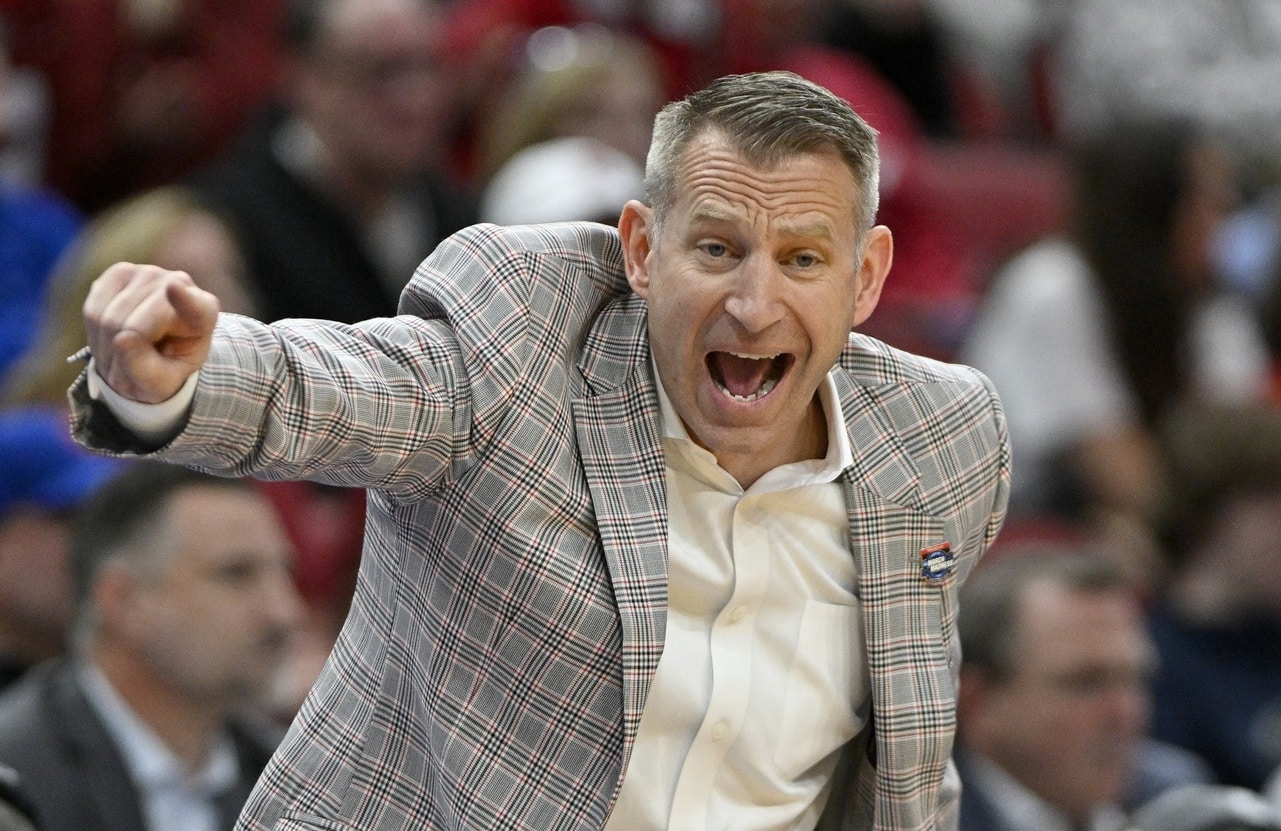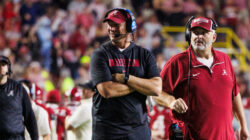
Nate Oats isn’t gonna overhaul his unique style, but perhaps we need to tweak our expectations of it
I’ve been a fan of Nate Oats’ style since he was at Buffalo.
It’s fun to watch a team that plays as fast as any team in the country who can light up the scoreboard with a barrage of 3-pointers while also defending at an elite level. When he was hired at Alabama, I thought his philosophy on how a team should operate was built perfectly for the modern era, especially at a place that was starved for 21st century success.
To be clear, I still enjoy watching Oats’ teams play, despite the fact that for the second time in 3 years, a season that included an SEC sweep also included a blown opportunity in the Sweet 16. When it’s right, there are few things more entertaining to watch. And even when it’s wrong, that defensive style still elevates Alabama’s floor to a place that’s still remarkably high.
But after the way things ended for the Tide — with a 3-for-27 showing from 3-point range that opened the door for San Diego State to crawl back after falling behind by 9 in the middle of the second half — perhaps it’s time to adjust our expectations of what the system’s March upside truly is.
We know that Oats isn’t ditching his high-volume 3-point shooting, up-tempo offense. He said as much in the aftermath of Friday night’s stunner in Louisville.
“I know we take a lot of threes, but the system worked for the entire year,” Oats said. “You know, we just — it’s one of those deals where I’m going to go back to the drawing board and see what I can get better at. We’re going to try to recruit really good players. A lot of programs would love to be in the NCAA Tournament three straight years. A lot of them would have loved to have won the SEC regular season tournament twice in the last three years.
“We’re doing pretty good things at Alabama, and we’re going to continue to get better.”
Nothing Oats said is incorrect. He’s right in that it is revisionist history to say that the system was always going to fail the Tide in crunch time. Many, myself included, labeled Alabama as the team with the highest floor and the highest ceiling in the tournament.
It is interesting, however, that Alabama was the only team who ranked in the top 30 in possessions per 40 minutes (tempo) who even reached the Sweet 16. Last year, Arkansas was the only team who ranked in the top 30 nationally in tempo who reached the Elite Eight, and go figure that the Hogs beat No. 1 overall seed Gonzaga, who ranked No. 5 in tempo, to get there.
Gonzaga and Arkansas were in that group in 2021, too. Gonzaga might’ve gotten to title games playing at that pace, but it also did so because unlike Alabama, it doesn’t rely heavily on the 3-point line. Last year’s Arkansas squad was No. 231 in 3-point attempts per game and that 2021 Gonzaga team was No. 232 in 3-point attempts per game.
The Zags saw their undefeated season come to an end in the national championship against a Baylor team who didn’t rank the top 200 tempo. For all the discussion about maximizing efficiency on both ends of the court — something Alabama has done extremely well under Oats — perhaps there’s more to be said for how quickly championship-caliber teams operate.
Lord knows when it got into crunch time, Alabama’s shot selection left something to be desired. Here’s where each of the last 10 national champs ranked in tempo (via KenPom):
- 2012 Kentucky — No. 150
- 2013 Louisville — No. 116
- 2014 UConn — No. 254
- 2015 Duke — No. 104
- 2016 Villanova — No. 274
- 2017 UNC — No. 40
- 2018 Villanova — No. 150
- 2019 Virginia — No. 353
- 2021 Baylor — No. 212
- 2022 Kansas — No. 65
So 8 of the last 10 title winners weren’t in the top 100 nationally in possessions per 40 minutes, and 2017 UNC was the only one to rank in the top 60.
As of this writing, the teams remaining in the 2023 NCAA Tournament field are FAU, UConn, Texas, Miami, Creighton and San Diego State.
None rank in the top 90 in tempo. Coincidence? I don’t think so.
So what does that mean? Should Oats overhaul his system and start slowing down the pace instead of giving Jahvon Quinerly the green light to not run any offense and get blocked at the rim by a guy with a 7-foot wingspan? Not necessarily.
It goes the other way, too. Ask Virginia and Tennessee fans about those disappointing March exits with that snail’s pace offense. I asked Virginia coach Tony Bennett about that after his team’s first-round exit to Furman, which continued the program’s NCAA Tournament victory drought since cutting down the nets in 2019.
“I mean, you just keep working. I think the guys had a terrific year this year being co-champs in the ACC, got to the championship game of the conference tournament and felt like we had this, and certainly lost,” he said last week. “The last time we were in the tournament we had the COVID deal and we got one practice. We had a key injury. So I can make situations why it’s been tough, but we lost in the first round … it doesn’t take away from what these guys have done and what we’ve experienced over the years, but you wanted it when you felt like you had it, and that was a tough one.
“But grateful to coach them, and keep building, keep trusting. And you’ve got a choice how you respond, and I will choose to respond the right way.”
Sounds awfully similar to Oats, doesn’t it? Of course, they’re on totally opposite ends of the tempo spectrum. But both were left with disappointing March exits wherein it felt like the system played a pivotal role in an earlier-than-expected exit. Again.
Neither Bennett nor Oats are ditching systems that are continuing to yield plenty of great regular seasons. And obviously, Bennett has the trump card of the 2019 national title. Nobody can ever take that away from him. Oats doesn’t have a feat like that just yet, so he’s certainly in a different spot.
It was Alabama’s most talented team ever. Going 19-2 against an 8-bid SEC is nothing to scoff at, the often randomness of March shouldn’t be cause to reinvent the wheel. Playing at the pace Alabama plays at helps Oats recruit both in the portal and at the high school level, which makes this more complicated.
But it’s hard not to question some of Alabama’s empty possessions in win-or-go-home games. In the regular the season, the Tide could often make up for that by rebounding, being unselfish and guarding at an elite level. Alabama is the rare team who usually checks all 3 of those boxes. It still lowers your floor and on a given night, it makes you vulnerable to get beat by a team who can also do those things and value possessions, just as we saw with San Diego State this year and 11-seed UCLA 2 years ago.
(By the way, that UCLA team who got into the field of 64 by virtue of winning a First Four game and went on to beat Alabama en route to the Final Four … it ranked No. 341 in tempo.)
The 4 post-Christmas teams that Alabama lost to all ranked No. 240 or lower in tempo. Not a coincidence.
Even a casual observer knows that Oats’ teams will always want to get up and down the court. But if he doesn’t dial it back a touch either in the speed his team operates or with the amount of long-range shots it attempts, maybe it’s time to stop assuming that even a great Alabama team has national championship upside.
This team prided itself on winning in a variety of ways. In the end, though, Alabama lost in all-too-familiar fashion. Oats doesn’t need an overhaul.
He does, however, need to determine if there’s a reason why such a uniquely constructed team is still searching for that March magic.
Connor O'Gara is the senior national columnist for Saturday Down South. He's a member of the Football Writers Association of America. After spending his entire life living in B1G country, he moved to the South in 2015.







